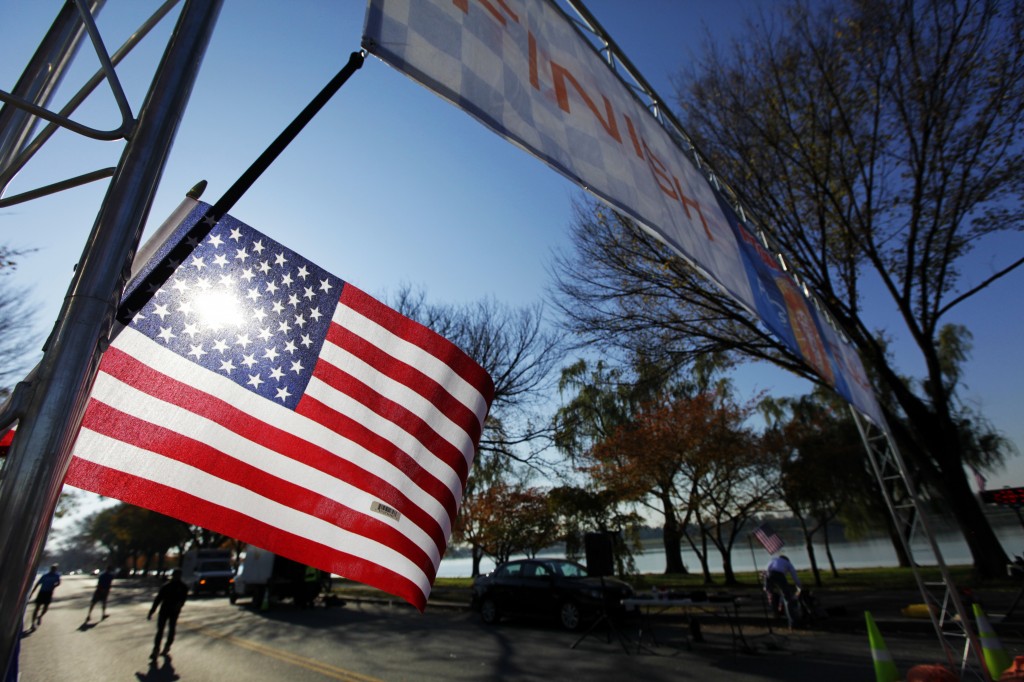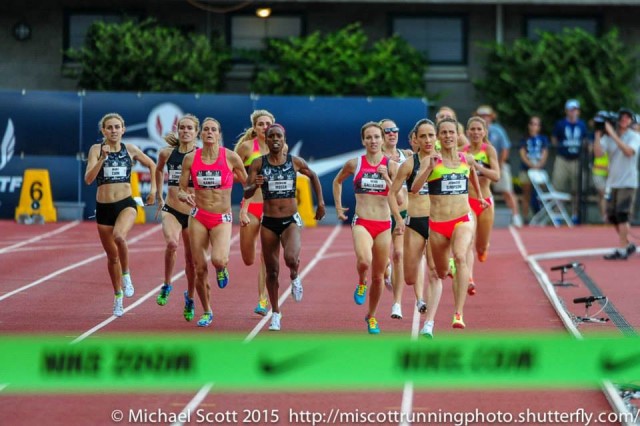
Around D.C., she’s known as the three-time Army Ten-Miler winner. Nationally, she’s the 1500 meter runner who has thrived at the USA Track and Field championships two of the last three years, finishing third on June 28.
[button-red url=”http://www.flotrack.org/coverage/252353-Lignano-Meeting-International-2015/video/776443-Womens-1500-Kerri-Gallagher-hits-IAAF-A-Standard-40356#.VZ1djvlVhBf” target=”_self” position=”left”] Watch the race[/button-red]Now, she’s ready to make her national team debut at the IAAF championships this August, after she blew by the qualifying mark July 7 in Italy. She ran 4:03.65 at the Meeting Internazionale di Atletica Leggera in Lignano, recording a more-than five-second PR, winning her race and breaking the meet record.
She is on a three-race trip through Europe that started with the express purpose of achieving qualifying time — 4:06.5, but with that accomplished, she can go into races in Belgium with less urgency.
In Lignano, she catapulted herself up the U.S. women’s standings for the year, ending up fifth at the end of the day July 7 from 15th before the race. In the process, she beat Alexa Efraimson, number four on the list and the junior U.S. recordholder at 1500 m, head-to-head. She also went from the 53rd fastest 1500 runner worldwide this year to 22nd.
“I thought 4:06 was very reasonable and knew I could do it. I didn’t expect much faster than 4:05, to be honest,” she wrote in an email the day after the race.
The race played out to her plan for running a fast time, following a rabbit through a 65 second first lap and 2:10 800 meter split. She led the third lap in 65 and held off Efraimson and Violah Lagat in the last half lap.
A varied approach to her racing this year — in which she has faced all sorts of conditions and tactics — gave her every reason to think she could squeeze another 13 meters into that time by the Aug. 9 deadline. Her last two seasons have seen her bring more deliberation and purpose to her races, learn a few hard lessons and continue her steady improvement.
“I tried to go out and run the Olympic trials standard every race,” she said of her 2013 season, which ended with a fifth place finish at the USATF meet. “I’ve since learned that it was a silly way to approach it, but it was a very necessary lesson that I needed to learn firsthand. From that year, I have a better idea how each race fits into the bigger picture.”
A hot May in the D.C. area may well have helped Gallagher, an Arlington resident and assistant coach at American University who is sponsored by Oiselle. The 90+ degree temperature primed her for racing in the Oregon heat wave, when the 98-degree high on June 26 set a record in Eugene while she raced her preliminary heat. Temperatures in Lignano were in the mid 80s around 9:30 Tuesday evening.
[button-red url=”http://www.usatf.tv/gprofile.php?mgroup_id=45365&mgroup_event_id=49&year=2015&do=videos&video_id=150622″ target=”_self” position=”left”] Watch the USATF 1500 m[/button-red] At the USATF meet in Eugene, “It had cooled down to the mid 80s with no sun by the final, but some people aren’t used to training in the heat as much, so their recovery might have been tougher,” she said. “I can handle the heat better than humidity, so I was fine.”
That confidence wouldn’t be shaken by a slow start to the final that saw her trail in last place for more than half of the race. A slow pace early would equalize the advantage the eight women with sub-4:05 times this season — the deepest final in history — would have.
“I just tried to stay out of trouble,” she said. “When you’re that close together and the pace is going slow, it was comfortable for how fast a lot of women have run, so there’s a lot of risk and tension.”
She knew from experience, stumbling on the inside rail in a Canadian meet and just missing a collision that took down sub-4 1500m runner Shannon Rowbury and Heather Wilson at the Oxy Invitational in California.
And sure enough, Gabe Grunwald fell off the track at 900 meters.
When Gallagher swung outside and took the lead briefly from 2011 world champion Jenny Simpson, commentators first neglected to mention her move, then called her “Kelly” Gallagher, clearly taken aback by her move.
“I was stride for stride with Jenny, just trying to keep up there,” she said. “When Shannon went by me, I knew I had to hang on and I felt like if someone else passed me, I might not have enough left to fight back. I’m just trying to swing my arms and keep driving. You’d seen so many blanket finishes at this meet, photo finishes … the teams decided by tenths of a second.”
Georgetown alumna Treniere Moser was on her heels, but as Simpson and Rowbury pulled away from the pack firmly into the top two spots, Gallagher did the same to third for a .27 edge over Lauren Johnson, with another Georgetown alumna, Rachel Schneider, finishing fifth, .01 second behind Johnson’s sprawling dive to the finish line. Simpson’s Diamond League victory last year gives her a bye to the IAAF meet, and allows four American women to compete.
Schneider, who is also racing in Europe, ended up pacing the race in which Johnson hit the standard, deferring her chance at the national team for the year.
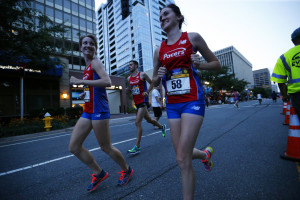
That Gallagher came into the USATF final with just the 15th fastest U.S. 1500 time this year was a symptom of the races she had been in, rather than a reason to cast doubt on her chances.
And she saw a lot of different kinds of races this year — being outmatched indoors, planning to kick, fighting chilly rain, running alone in the front, and attempting to recover from nearly falling over other athletes. Each fortified her skill in a different phase of the race.
“In Canada, I was through 1200 meters faster than I ever have before, and then I fell,” she said. “I can run this time.”
In addition to the cumulative strength gains she has made over the last four years, her mental approach has settled on one suited for her newfound endurance and thanks to advice from her coach, Matt Centrowitz.
[button-red url=”http://www.iaaf.org/records/toplists/middlelong/1500-metres/outdoor/women/senior/2015″ target=”_self” position=”left”] 1500 m rankings [/button-red]
“He’s been telling me for years that I’m not a kicker anymore, so I should stop thinking about a 100-meter kick or a 200-meter kick. It’s more like a 600-meter drive,” she said. “Every year I get a little stronger, more confident with that mindset.”
Centrowitz said the longer distance training in the fall has been a big part of that.
“She’s gone from barely breaking 60 to winning the Army Ten-Miler in 54 minutes,” he said. “That pays off not just in the 1500 meters, but when you’ve got heats and have to be ready to run more than one race.”
Consistently good health has also played a part in this season’s successes. A stress fracture hobbled her in 2014, a year, perhaps not coincidentally, in which she did not make the USATF 1500 meter final.
“She’s been healthy for 18 months, and when you have that momentum, its easy to keep things going and improve,” Centrowitz said.
She’s also more comfortable taking chances, and it paid off at the Penn Relays. After two lackluster races in which she went out conservatively, Centrowitz encouraged her to be more aggressive, and it paid off, with her first win in at that meet’s Olympic development mile.
Though Centrowitz raced internationally during his career as an Olympian at 1500 and 5000 meters in the late 70s and early 80s, he doesn’t see much that he can offer her as she goes to Europe for the first time in her life on an important business trip.
“It’s even different from last year when Matthew (his son, a two-time world championship medalist at 1500 meters) was in the Diamond League, but I’m not worried about her, even with time zones and people pushing her around,” he said. “She’s obviously very bright and she can handle herself. She’s a New Yorker.”
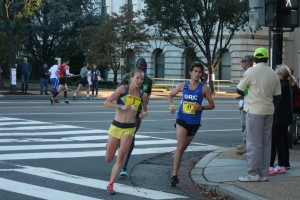
Gallagher grew up in Queens before running at Fordham University in the Bronx. After a tepid race at the 2011 NCAA championships, she figured her serious racing career was over. Ninety minute-long track practices made way for commutes that long each way to a job in financial services in Manhattan.
After a few weeks, she talked to her Bishop Kearny high school track coach, John Lovett, and mentioned the track-sized gap in her life. Centrowitz, a friend of Lovett’s, found a place for her on the Pacers-New Balance training group and it was goodbye Big Apple, hello nation’s capital.
“I recruited Kerri when she was looking at colleges and really wanted her to come to American,” he said in 2013. “I understood when she chose Fordham, she wanted to be close to home, but I still followed her progress and maturation on and off the track. I knew I wanted to work with her and I finally got my chance.”
Gallagher’s introduction to summertime in Washington in 2011 was not easy and breezy. The heat, humidity and the miles were staggering, but she found herself adjusting to her new home pretty well. Living with Centrowitz’s daughter, Lauren, helped, Centrowitz said, because she helped Gallagher adjust mentally and emotionally.
“She’s been living at home or in the dorms all her life, there was going to be an adjustment,” he said. “She comes from a close-knit family, so I was a little worried about her being homesick. I wasn’t worried about her fitness.”
Gallagher acquitted herself of the Washington area’s running amenities quickly, though she now affiliates herself with the New York Athletic Club.
“D.C. has a lot of things going for it that New York can’t match,” she said. “A lot of New Yorkers wouldn’t admit it, but it’s working out pretty well for me.”
Trails within a few minutes’ trot from American’s campus in Tenleytown and Roosevelt Island near her home in Rossyln beat driving to Van Cortlandt Park in the Bronx.
She got her introduction to running from her mother, Patricia. Neither she nor her father John ran, but they saw some dissatisfaction from her when she was on the JV basketball team, keeping the bench nice and safe for when her teammates came off the floor.
“I don’t know where she came up with the idea, but I’m glad she did,” Gallagher said.
Now running is a family pastime, with five of her nine siblings serious about running. Mary ran for Saint Francis College in New York, Conor and Liam run at Malloy College in New York and Jackie and Tess run at Bishop Kearny.
Despite not thinking much of running around in circles, as she regarded track, she was a hit in the middle distances, and became seriously interested in running in 11th grade. Lovett told her she can run in college, somehow. Fordham was interested, and she found her place on the 4×800 meter relay, safely ensconced in the team.
“I was the fourth leg of the 4×8,” she said. “They needed me to race, but I wasn’t a difference maker.”
As in high school, her enthusiasm jumped during her junior year, when she started focusing on the 1500 meters. Her times had been dropping steadily, 5:03 as a freshman, hitting 4:48, 4:36, 4:20 each successive year.
She ran cross country, too, but barely approached the girls she would race to the finish line on the track.
She loves the 1500 because it’s half speed and half strength.
“It’s unique, other races don’t have that,” she said. “It’s where strength and speed meet. A fast person can reach and run the 1500, a strong person can gut one out. I’ve had the same 200 meter times since high school, but the difference has been my strength in the last year(s).”
[button-red url=”https://itunes.apple.com/us/podcast/pacers-running-podcast/id991180280?mt=2&ign-mpt=uo%3D4#” target=”_self” position=”left”] Kerri on “Pace the Nation” [/button-red]Her track runner’s offseason got more serious in Washington. Centrowitz had her run in races much longer than her college cross country jaunts, and her victory and steadily-dropping time at the Army Ten-Miler is becoming a fall tradition after three years. Her first winning effort averaged faster than her college 5k PR, and her time for her off-distance specialty has gone down to 54:50 from her debut time of 59:47.
What she needed, Centrowitz said in 2013, was to learn to change her outlook to benefit her training.
“If you want to be a top runner, you have to be self-centered,” he said. “That’s a challenge for her because she’s such a generous person, she tends to put herself behind the needs of others. There’s a way to work around that, but she still has to be able to put herself first.”
In 2015, he said that she had mastered that, thanks to some mentoring by former training partners, including his daughter Lauren and former American standout Erin Koch.
“When they graduated out of the program, she stepped up and showed what she could do, she learned how to assert herself in workouts and races,” he said.
Now she gets some company in workouts from Jesse Carlin, an 800 meter specialist training under Centrowitz. Julie Culley, a 2012 Olympian in the 5000 meters, has also joined workouts, when healthy.
Gallagher leans as much on Centrowitz’s mastery of the ancillary aspects of competitive running as the mechanics.
“Knowing he has been there before with things like your managing expectations has been really important,” she said.
As she prepares for races in Belgium July 11 and 18, she has a cadre of American athletes with whom to spend her time while in Europe.
“As it turns out, a lot of American runners do the same races here so I’ve been able to link up with some people I know through racing and have met some new as well,” she wrote. “While I came out here on my own, I’m not on my own which is great. There are also a few agents and coaches at the races that give splits and help make sure we know what we are supposed to do and when on race day.”
On July 17, Gallagher got to be a part of a historic race in Monaco, in which Ethiopian Genzebe Dibaba ran 3:50.07 to break the world record and Rowbury ran 3:56.29 for the American record. Gallagher finished 11th in 4:06.07.
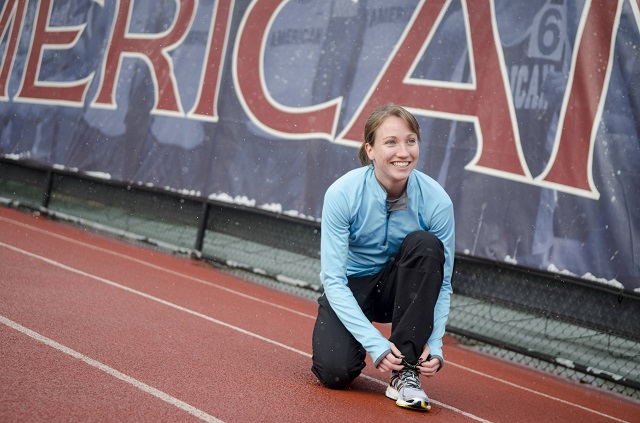
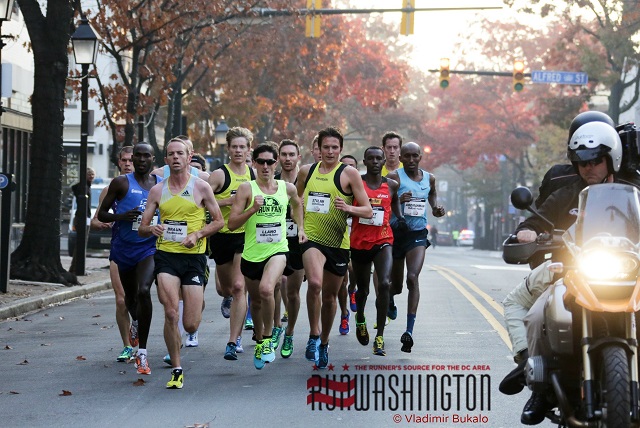
Season after season, on the track, on the roads – at one national championship after another – Aaron Braun has been in the mix, establishing himself as one of the top distance runners in the country.
Braun, 26, broke through to the top this morning on the streets of Alexandria – taking firm control at the 10k mark of the .US National Road Racing Championships to win his first national title. Results
The inaugural championship race capped the 2013 USA Running Circuit (USARC), a road racing series that includes national championships for races ranging from the mile to the marathon. The first 10 U.S. runners in these races earn points, with 15 awarded for a win.
The .US National Road Racing Championships, however, offered triple points, not to mention $100,000 in prize money. And it was contested at the uncommon distance of 12k, an unfamiliar distance serving as something of a middle ground for 5k specialists and marathoners.
What made today’s race interesting, though, was not so much the unique race distance; it was the time of year the race was held. Some of the pros entered in today’s race had run marathons the month prior. Some had been racing relentlessly since January (and coming off a marathon), thus operating on fumes. Others, like Braun, came in focused and fresh.
The lead pack was at least a dozen strong through 5k. But Braun – from the very beginning on Union Street – seemed to be the one tugging the strings, injecting fresh pace at mile marks or surging off some of the course’s tight and even 180-degree turns.
The opening pace through the first few mostly-flat miles was about 4:40. Spectators lined the intersections to cheer, and Abdi Abdirahman and Shadrack Biwott at times moved out into the lead.
Pre-race favorites Matt Tegenkamp, leading the USARC standings, and Chris Solinsky tucked into the group. Solinsky, who dropped out, started to fall off first, shortly around 5k. Tegenkamp started slipping back closer to a turnaround near five miles.
“Coming off the marathon, I was just locked into those 4:50s, 4:55, five-minute miles,” said Tegenkamp, an Olympian who debuted in the marathon Oct. 13 in Chicago, clocking 2:12:28. “Trying to run any faster than that for a sustained amount of time, there was just never a comfort zone.”
Tegenkamp fought through a tough day to finish eighth.
Braun, meanwhile, lowered the pace into the 4:30s. He said he knew dropping the field wouldn’t happen and focused instead on staying aggressive: “… I just had to keep my foot on the pedal and keep it nice and steady, be able to hold that pace all the way to the finish.”
Braun’s time, 34:28, was two seconds shy of Steve Spence’s American record. Maybe if Braun had not looked back in the closing stretch and waved to the crowd and enjoyed the moment … maybe then the record could have been his.
But the Englewood, Colo.-based runner was not the least bit concerned about that. His only goal, he said, was to win: “It’s just so great to finally cross the line and be U.S. champion.”
Braun recently returned to a former coach and his native Colorado, where he also attended running powerhouse Adams State College. He made the change, he said, out of concern that his performances had leveled off.
“To keep in this sport,” Braun said, “you have to keep getting better – because everyone else is getting better, too. So if you’re staying the same, you’re getting passed. I am just determined to keep getting better year after year.”
Sensing Braun was on his game, Shadrock Biwott – second in the standings – focused on not letting him get too far away.
Biwott has been racing without a break since January, he said. Six weeks ago he finished third in the national marathon championships – and afterward took just two days off. (“I’m exhausted,” he said. “My legs are tired right now. I have never been so tired in the race.”)
His near-breaking point came while heading up the bridge between miles five and six. There was a tight turn to make at its end – and Biwott, entering his rough patch, said his focus was further thrown by seeing Abdirahman take a hard fall there that ended his race.
But Biwott successfully re-grouped to hold on for second, seven seconds behind Braun – a result that earned him the USARC series title.
Next in the 12k was Tyler Pennel, 25, of Blowing Rock, N.C., finishing third in 34:37.
It was Pennel’s first race since Peachtree in July, and his first race in a new season he hopes will peak in January at the national half marathon championships.
“It kind of validates the training I am doing with my coach,” he said. “I know I can compete with these guys. I can go out here and run toe to toe with them.”
Local Connections
Chris Kwiatkowski of Washington, D.C., recently finished fourth at the Army Ten-Miler in a new personal best of 48:17. He is coached by Matt Centrowitz and runs for the Pacers-New Balance team.
Kwiatkowski ran confidently this morning in the thick of the lead pack. He started to lose contact around five miles but held on to finish 12th.
“It’s a different world the way these guys race,” he said. “You got to be strong; you got to stay relaxed. So I’m working on it, and it was a good learning experience.”
Matt Llano trains in Flagstaff, Ariz., but attended Broadneck High School in Annapolis and competed for the University of Richmond.
He finished seventh today in 34:49, matching his place at the national 20K championship in September and continuing his recovery from an injury that sidelined him for most of 2012. His parents, sister, college teammates and even his former college coach were there to see him race.
Llano hoped to crack the top five, but “I’m just confident that my fitness is still coming along,” he said.
Thomas Jefferson High School graduate Christopher Landry, who now trains in Ann Arbor, Mich., finished fourth to cap a USARC season that also included top five finishes in the national championships for the marathon and 25k.
The College of William and Mary graduate wasn’t sure how he would fare at 12k six weeks after a marathon. But today’s race – “a homecoming,” he said, with his family there supporting him – wasn’t one he wanted to miss.
“This exceeded all my expectations,” he said.
—
RunWashington’s story on women’s race.

The road under her feet still felt odd to while she held a slim lead in the 2012 Army Ten Miler.
She wasn’t hugging the inside lane, her shoes were spikeless and there was no chance an official would restart the race if someone fell in the first stretch.
She was racing 10 times longer than her preferred distance, and she evaluated how she felt.
“I didn’t plan to go to the front but I was there and figured if I could lead the Army 10 mile, that alone would be a story,” she said. “I never thought I’d be in this position, and nobody would notice if I was first or 20th. I knew if I was going to compete seriously, I was going to have to keep the pace honest and keep pushing.”
Four miles in, after hanging back in the lead back with training partner Erin Koch, she surged to the lead and to her surprise, nobody challenged her. Ethiopian Aziza Aliya-Abate trailed her by three seconds at 10k and passed her after seven miles.
She thought for a split second that it was okay, her time in the lead was over. Why shouldn’t it be? She wasn’t supposed to be up there, she’s just building strength for track with these races. Then, her competitive instinct kicked in, the reason she raced, and her mind moved onto something else, maybe two lines of a Ke$ha song. The doubts were gone, never to resurface.
Gallagher held that lead, one second, to the finish, and made it the second closest finish the race had ever seen. Her 56:09 was also the third fastest women’s time.
She discovered she was more than a four-lap phenom.
“I’m more of a distance runner than I could have ever imagined,” she said.
Gallagher’s transition to longer distances has paralleled her transformation to a Washingtonian after living in New York for her entire life. She grew up in Queens, went to college in the Bronx and worked in Manhattan.
Her day job, as an assistant track coach at American University, is a world away from her first job after graduating from Fordham University — working in client services in a financial services company.
After a tepid race at the NCAA championships first round, she figured her serious racing career was over. Ninety minute-long track practices made way for commutes that long each way.
After a few weeks, she talked to her Bishop Kearny high school track coach John Lovett, and mentioned the track-sized gap in her life. Matt Centrowitz, the former American Record holder and coach at American University and a friend of Lovett’s, found a place for her on the Pacers New Balance training group and it was goodbye Big Apple, hello nation’s capital.
“I recruited Kerri when she was looking at colleges and really wanted her to come to American,” he said. “I understood when she chose Fordham, she wanted to be close to home, but I still followed her progress and maturation on and off the track. I knew I wanted to work with her and I finally got my chance.”
Gallagher’s introduction to summertime in Washington in 2011 was not . The heat, humidity and the miles were staggering, but she found herself adjusting to her new home pretty well. Living with Centrowitz’s daughter, Lauren, helped, Centrowitz said, because she helped Gallagher adjust mentally and emotionally.
“She’s been living at home or in the dorms all her life, there was going to be an adjustment,” he said. “She comes from a close- knit family, so I was a little worried about her being homesick. I wasn’t worried about her fitness.”
Gallagher acquitted herself of the Washington area’s running amenities quickly.
“D.C. has a lot of things going for it that New York can’t match,” she said. “A lot of New Yorkers wouldn’t admit it, but it’s working out pretty well for me.”
Chief among them is her easy access, from her home in Chevy Chase, to miles of trails within a few minutes of running.
“If I wanted to run on grass, my option was pretty much Van Cortlandt Park,” she said. “Six minutes of running gets me to Rock Creek Park.”
She got her introduction to running from her mother, Patricia. Neither she nor her father John ran, but they saw some dissatisfaction from her when she was on the JV basketball team, keeping the bench safe for when her teammates came off the floor.
“I don’t know where she came up with the idea, but I’m glad she did.”
Now four of her nine siblings, one brother and three sisters, are serious about running. Mary ran for Saint Francis College in New York, Conor is a sophomore at Malloy College in New York and Jackie and Tess are sophomores at Bishop Kearny. They’re all working on Vincent, a fourth grader, to join them on the track someday. Liam, a high school senior runs cross country, but favors baseball.
Despite not thinking much of running around in circles, as she regarded track, she was a hit in the middle distances, and became seriously interested in running in 11th grade. Lovett told her she can run in college, someway. Fordham was interested, and she found her place on the 4×800 meter relay, safely ensconced in the team.
“I was the fourth leg of the 4×8,” she said. “They needed me to race, but I wasn’t a difference maker.”
As in high school, her enthusiasm jumped during her junior year, when she started focusing on the 1500. Her times had been dropping steadily, 5:03 as a freshman, hitting 4:48, 4:36, 4:20 each successive year.
She ran cross country, too, but barely approached the girls she would race to the finish line on the track.
That track runner’s offseason got more serious in Washington. Centrowtiz had her run in races much longer than her college cross country jaunts. The Army Ten, Philadelphia’s Rothman 8k, some cross country races. She was already improving dramatically, running 5:38 pace for a 6k cross country race at the USATF Club Cross Country Championships in 2011, compared to her 5:57 pace for 5k at the Atlantic 10 championships the year before, a race that was only 5k.
Her 2012 spring season topped off at the Swarthmore Last Chance Meet, when she ran 4:16.07 to finish fourth, behind
two women who would run in the Olympics that summer — Canadian Sheila Reid and American Julie Culley — and one who would end up being the only woman to beat her that fall– Carmen Hussar.
She adjusted her racing tactics dramatically.
“I was running toward the back a lot,” she said. “You can get away with that in the Atlantic 10, but at this level, you can’t do that because they’ll get away from you.”
Last summer, she added more mileage, hitting 80 miles a week at times. Centrowitz said he noticed a distinct change in her focus and attitude when she started her second year in Washington.
“If I want to run faster, I’ll have to push the envelope,” she said. “Coach has been really good about identifying what I need to do and when I need it.”
What she needs, Centrowitz says, is to learn to change her outlook to benefit her training.
“If you want to be a top runner, you have to be self-centered,” he said. “That’s a challenge for her because she’s such a generous person, she tends to put herself behind the needs of others. There’s a way to work around that, but she still has to be able to put herself first.”
She loves the 1500 because it’s half speed and half strength.
“It’s unique, other races don’t have that,” she said. “It’s where strength and speed meet.
A fast person can reach and run the 1500, a strong person can gut one out. I’ve had the same 200 meter times since high school, but the difference has been my strength in the last year.”
That showed when she went back to racing out of character in the fall. The Clarendon Day 10k– where she beat British Olympic marathoner Claire Hallissey. The New York 10k. The Jingle All the Way 8k. Hussar beat her at the Veterans Day 10k, but that was after she made her mark at the Army Ten, where she ran her college 5k PR more than three times in a row.
In addition to her added endurance, she’s now confident enough to lead, to race from the front, something she’s picked up from Koch.
“I’ve gotten tougher just trying to be like Erin,” she said. “I need to push my comfort zone, I need to be confident enough to make a move and go with it, and she’s helped me learn how to make that happen.”
Despite all she’s achieved with her running in the latter months of 2012, Centrowitz sees plenty of room for improvement.
“I don’t think she’s scratched the surface,” he said. “Her speed, her strength, the mental side of racing, she has a lot she can improve on, and she’s hungry for it. If we work together four or five years, she’s going to get somewhere. She’s extremely coachable and that’s a credit to Lovett and (Fordham Coach Tom) Dewey, she had great experiences with them and it’s easy for her trust me.”
When she’s not running or helping manage the Eagles’ runners, she yearns to hear good live music, especially Celtic.
As an undergrad at Fordham, she hosted an Irish music program on the college’s radio station, called Ceol na Gael, one to which her grandparents introduced her as a child.
“I got to meet musicians, talk about what I liked,” she said of the show. “It was a unique college experience, one not a lot of people got to have. Having listened to it so long made it more special.”
While racing the Veterans Day 10k last Sunday, runners felt a strange sensation as they rounded Hains Point — still air. It was a rare-enough occurrence that some may have wondered if they would later dine on a breakfast of dodo eggs and unicorn steak.
[button-red url=”http://old.runwashington.com/veterans10k/race-history/event-records.htm” target=”_self” position=”left”] Results [/button-red]Just two weeks prior, runners dealt with four miles of variable winds as they rounded West Potomac Park, vulnerable to the breezes coming off the Potomac River in the middle of the Marine Corps Marathon. This morning, a pack of Pacers Racing Team members cruised along in the sun, exerting a measured effort that blew away last year’s times.
Chris Kwiatkowski, a recent University of Oregon graduate in town to train under coach Matt Centrowitz, started to pull away after 5k on his way to a 29:47 victory.
In his first post-collegiate year, Kwiatkowski, of Chevy Chase, is trying to adjust to the lack of cross country racing to which he’s become accustomed. The distance certainly isn’t an issue for him, not with a 49:09 sixth place finish at the Army Ten Miler to his credit.
“I guess the closest thing to cross country is long races that force you to get strong,” he said.
Columbia, Md. resident Joey Thompson edged last year’s winner Frank DeVar to the finish line in just under 30 minutes, well ahead of his DeVar’s 30:23 time then.
Kwiatkowski, DeVar, Jeff Brannigan, Matt Barressi and Kerri Gallagher led the Pacers New Balance team over the Georgetown Running Club, consisting of Jerry Greenlaw, Sam Luff, Ryan Witters, Alex Benway and Beth Young.
Canadian middle distance runner Carmen Hussar’s family was in Washington for the weekend, which led her to the race. She’s putting in high mileage between track seasons and the race fit comfortably into her schedule, as she won in 33:45 over Army Ten Miler champion Gallagher.
“I loved the course,” Hussar said. “Running into the sun, the nice weather, and I had a good group to run with.”


